This is a Chinon CE-4 35mm SLR made by Chinon Industries Inc starting in 1980. It was Chinon’s first SLR using the Pentax K-mount, after they abandoned the M42 screw mount. The CE-4 was quickly upgraded to the CE-4s model which revised the shutter speeds and meter sensitivity to better compete with other models. Although a less well known brand, Chinon cameras generally compare very favorably to models made by more well known companies like Pentax and others. Chinon SLRs have proven to be just as reliable as their competition, usually working as good as the day they were made, decades later.
Film Type: 135 (35mm)
Lens: 50mm f/1.9 Auto Chinon coated 6-elements + others
Lens Mount: Pentax K-mount Bayonet
Focus: 1.47 feet to Infinity
Viewfinder: Fixed SLR Prism with microprism collar and split image focus aides
Shutter: Seiko Vertically Traveling Focal Plane Shutter
Speeds: B, 8 – 1/1000 seconds, stepless in AE
Exposure Meter: 2 x Blue Silicon Photo Diode TTL Meter with Aperture Priority AE
Battery: 3 x LR44 1.5v alkaline or silver oxide cells
Flash Mount: Hot Shoe and PC X Flash Sync
Manual: http://www.butkus.org/chinon/chinon/ce-4/chinon_ce-4.pdf
History

Chinon is a name not often associated with collectible cameras. For those active in the 1970s, you probably remember them as a maker of discount screw mount and Pentax K-mount SLRs. Their cameras were quite well built, but they weren’t exactly a company known for innovation. In fact, many Chinon made cameras were rebadged and sold under the brand names of other manufacturers such as Argus, GAF/AGFA, Revue, Sears, Alpa, and Albinar. As a result, there are far more Chinon made cameras out there than most people probably realize.
The company was originally formed by Chino Hiroshi in September 1948 as Sanshin Seisakusho in Tokyo, Japan. Unlike other Japanese optical companies of the time, Chinon seemed to be in the business of making parts for other optics companies. As best as I can tell, in the 1950s, they made camera lens frames and lens barrels for a variety of companies. It doesn’t look like Chinon had any of their own optical products until 1958 at which time they released their first 8mm motion picture camera lens.
The company would change it’s name in 1962 to Sanshin Optics Industrial Co. Ltd, and then once again in 1973 to Chinon Industries Inc. As best as I can tell, the company’s first 35mm camera was made in either 1971 or 1972, and I believe it was the Chinon M-1, a rather basic mechanical SLR with an M42 lens mount.
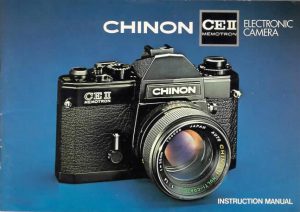
Finding a comprehensive history of Chinon and their early products has proven to be a bit of a challenge. For a brief moment in the mid 1970s, they released a couple of innovative aperture priority auto exposure cameras using the M42 screw mount called the CE Memotron series. The Memotrons used a clever shutter release that would stop down the iris and take an AE reading moments before firing the shutter. Other companies had attempted AE on screw mount cameras, but they usually had a compromise such as requiring a special lens for it to work correctly. The Memotron series would work with any screw mount lens, as long as it had the automatic diaphragm pin.
By the time the CE-3 Memotron was released in 1977, most every other SLR maker had abandoned the M42 screw mount and was using some form of bayonet mount. Even Asahi Pentax, who was one of the biggest supporters of the M42 mount, had released the K1000 in 1975 with their new Pentax K-mount. Bayonet mount lenses are superior to M42 screw mount lenses not only because they are quicker to take on and off, but they allow for a much more precise mount which allows for features like coupling pins, auto focus motors, and electrical connections.
When Asahi Pentax had released their new K-mount in 1975, it was developed in cooperation with Zeiss and was intended to be a universal mount that could be used by a variety of manufacturers. Zeiss would never actually produce a K-mount lens, but other companies would.
In 1980, Chinon would be one of the first third party manufacturers to embrace the K-mount with two new SLRs called the CM-4 and CE-4. The two cameras were very similar, with the major difference being the former had a fully mechanical shutter with no automatic exposure, and the latter had an electronic shutter with AE. Keeping with tradition of making cameras for other brands, the CE-4 was also branded as the AGFA Selectronic 3 and Revueflex AC-2.
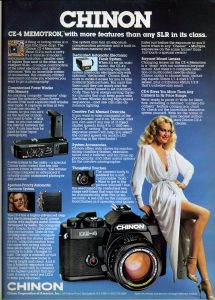
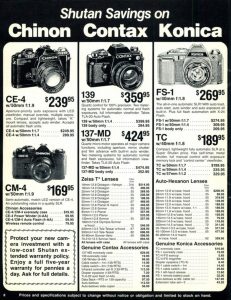
As with previous Chinon SLRs, the CE-4 was well built and had a competitive feature set for the price. The magazine ad to the left sells the CE-4 as having more features than any SLR in it’s class. The page to the right from Chicago’s Shutan Camera Summer 1981 catalog lists the CE-4 with 50mm f/1.9 lens for $239.95. The same catalog lists comparable cameras like the Konica FS-1 for $269.99, Minolta XD-5 for $299.99, and Nikon FE for $299.99. It wasn’t the cheapest AE capable SLR available, as models like the Olympus OM-10 and Pentax ME beat it, but with a reduced feature set.
The early 80s was a period of quick advancement in camera design as features like automatic exposure with electronic shutters was still pretty new, but features like auto focus and more advanced metering choices were right around the corner.
The CE-4 was only in production for a year, before a slightly revised model called the CE-4s was released in 1981. Changes to the updated model included a new top 1/2000 shutter speed (although the manually selected 4 second speed was missing), an improved viewfinder, and subtle changes to the light metering circuit. Whether these changes were done as a way to make the camera more competitive, or if they were necessitated by a technology or manufacturing change, is anyone’s guess.
I was unable to find any information about how successful these models were or how many were sold. I can’t even conclusively say when the models stopped being produced, although the release of the Chinon CE-5 in 1983 is a pretty good guess.
Today, the CE-4, or most Chinon SLRs for that matter are not highly sought after by collectors. But those who remember them, will likely tell you that they were very capable K-mount alternatives to those offered by other companies. If your goal is to take 35mm photos with an AE capable SLR camera that uses K-mount lenses, you could do worse. As a result, CE-4s in working condition often go for bargain basement prices. You could pick up a nice Chinon CE-4 with 50mm prime lens for a lot cheaper than many other SLRs sell for without a lens.
My Thoughts
I first became aware of Chinon SLRs when researching the CE-II Memotron for that camera’s review. I had a pretty decent selection of M42 screw mount lenses and wanted to find an auto exposure capable camera to use them with. The CE-4 showed up as a compact and modern camera, but it used K-mount lenses, which at the time I had no interest in. But then one day, I came across one at a garage sale in a case, with the motor winder, a couple third party lenses, and a Chinon branded flash. $10 later and the whole lot came home with me.
The winder was hopelessly corroded and the third party lenses were of no interest to me, so that left me with the body, the Chinon 50mm prime and the flash. I cleaned up the camera, put in 3 fresh batteries and the camera seemed to work great!
By the 1980s when this camera had come out, most Japanese SLRs were designed in much the same way. They had comparable feature sets, ergonomics, and looks. The most logical comparison this camera has to another in my collection is to the Pentax ME Super, which not only was sold at the same time as the CE-4, but it also shares the same Pentax K-mount.
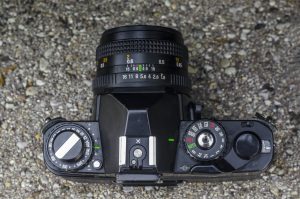
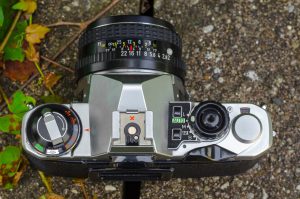
Both the Pentax and Chinon have similar control schemes with only one major difference, which is the manual shutter speed control. The Pentax favors two up/down buttons that change the shutter speed when the camera is in “M” mode. The Chinon has a more traditional shutter speed wheel that you simply turn to whatever your chosen speed is.
The Pentax further complicates this with a tiny white button that must be pressed to move the selector out of Auto mode. I found this to be very cramped and difficult to press with my fat fingers. While both of these cameras were likely targeted at customers who used both in AUTO mode 99% of the time, this likely wasn’t a major issue for most people, and I appreciate Pentax’s effort at modernizing the controls, but I think the Chinon’s system is slightly easier to use.
Another minor difference is in how the film speed and +/- EV control scheme works. Chinon employs a simpler system in which you turn the control dial so that your chosen film speed is next to the green line. If you want to over or under expose your film, turn the dial so your chosen film speed moves toward the + for overexposure or – for underexposure. Each click of the film speed dial represents a 1/3 EV change in either direction. The Pentax uses a system in which you lift up on the dial to set your chosen film speed in the small window at the bottom of the dial, and then turn the whole thing either clockwise for underexposure, and counterclockwise for overexposure. I can’t really say one system is better than another as I would bet that 99% of the people who bought this camera never used either feature. Chinon’s system that requires a press of a little button before this dial can be changed was probably a bit more foolproof in that it would have been harder to accidentally change.
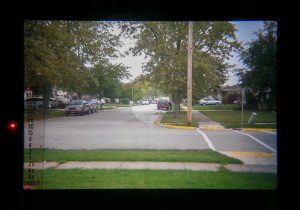

The Pentax’s viewfinder on my example was a tad brighter overall, as the Chinon had an ever so slight yellowish hue to it. It’s plausible that this yellow tint is a result of the plastic viewing screen yellowing over time as some plastics tend to do. I cannot be sure if this would have been there when the camera was new, so its possible that brightness was the same 30 years ago when these cameras were new. In the images to the left and right, you can’t even see the difference, but when looking at it in person, it’s subtle, but there.
Both have split image focus aides surrounded by a microprism collar, and both indicate the chosen speeds using a scale of LEDs on the left side of the viewfinder. The Pentax ME Super shows speeds from 4s to 1/2000 and the Chinon CE-4 shows speeds from 8s to 1/1000 (although this was changed in the Chinon CE-4s to match that of the Pentax). Where the Pentax has a bit of an edge is in that the LEDs are different colors indicating slow speeds. 1/60 and up are all green indicating that the camera can most likely be safely used handheld. 1/30 down to 4s are all yellow indicating that you’d want to stabilize the camera to prevent camera shake. Finally, there is a red LED next to “OVER” and “UNDER” meaning the camera’s meter will not be able to expose the scene correctly at the chosen aperture value. I found these color coded LEDs to be a nice touch, especially for the novice that this camera was likely marketed towards.
Beyond these differences, the rest of each camera is pretty similar. Both have a soft press shutter release comfortably located on the top plate where you’d expect it to be. Both have plastic tipped wind levers that swing out approximately 180 degrees and have exposure counters on the right side of the top plate. Both cameras have a self timer on the front, although the Chinon’s is electronic and has two values, 5 second and 10 seconds whereas the Pentax’s is mechanical and has a variable 4 – 10 second delay.
Both cameras can achieve double exposure by manipulating the rewind release button while advancing the camera, and both cameras use the same SR44/357 button cell batteries, although the Chinon requires three, compared to the Pentax that uses two.
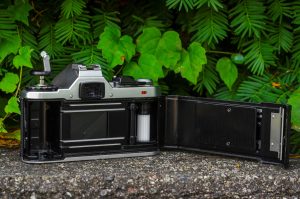
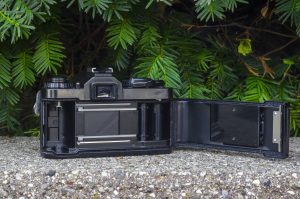
Loading film in both cameras is almost identical as well. Pull up on the rewind knob to unlock the film door and load a new 35mm cassette on the left side and pull the leader to the takeup spool on the right. The Pentax’s takeup spool has a unique multi slotted spool in which you can insert the leader in almost any orientation, whereas the Chinon has a more standard slitted spool that requires the spool be in a more specific location. The ME Super also has a red film transport that indicates proper loading of film when the door is closed.
If I were a consumer in 1980 at a camera shop looking for an easy to use 35mm SLR for vacation photos and I required a lightweight and compact body with automatic exposure, both of these cameras would have been good “bang for the buck” contenders. The Chinon offers a few things I like better like a more standard shutter speed dial that is easier to change and doesn’t have tiny buttons that aren’t easy to locate with the camera to your eye. Also, while it probably wasn’t used often, I think Chinon’s more standard EV compensation system simply works better, plus it offers a way to lock in your setting so that it can’t be accidentally changed.
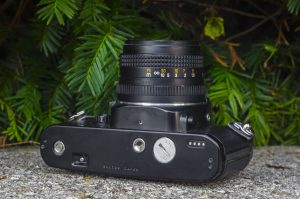
The Pentax though, has an easier film loading system with the convenience of a film transport indicator, and I appreciated the multi-colored LED indicators in the viewfinder. These features likely were more important to novices than a slightly easier exposure compensation system and more straightforward manual controls. Perhaps the nail in the coffin for the Chinon is that according to the 1981 catalog referenced above from Shutan Camera in Chicago, both the Chinon CE-4 and Pentax ME Super equipped with each brand’s respective 50mm f/1.7 lens sold for the exact same price of $249.99. Chinon might have been able to market the value of their camera compared to more expensive brands like Nikon or Minolta, but there was other competition out there keeping pace from a value standpoint.
Finally, in terms of size and weight, the Pentax ME Super is both smaller and lighter than the Chinon CE-4 in every way, width, prism height, and top plate height. Without lenses attached, but batteries installed, the CE-4 weighs in at 497 grams compared to the ME Super at 448 grams.
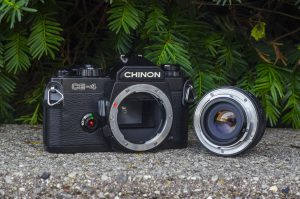
Both cameras were well designed and solidly built examples of late 70s/early 80s SLR technology. Both used the same Copal Square vertically travelling metal blade shutter and both could use the same exact K-mount lenses suggesting that the quality of the images would have been identical between the two. As a potential customer during this era, you could do much worse with other cameras, however I’ll speculate that more people probably preferred the Pentax for it’s more recognizable brand name, more compact and lighter body, and it’s improved “novice” features. Although I could not find sales figures for either camera, the fact that the Pentax brand still exists today, and Chinon stopped selling cameras before the end of the 80s suggests my theory is correct.
My Results
Continuing with the theme of comparing the CE-4 to the ME Super, I shot both cameras back to back with the intent of getting the reviews out at the same time, but life had other plans and it turned out that the CE-4 review will come first, with one for the ME Super to follow. I’ll update this review with a link once it posts.
My first roll through the CE-4 was Kentmere 100 and I shot it this past summer on some random days around where I live. Keeping in the spirit of the target customer who likely bought this to be a family “snapshot” camera, I took pictures of every day life. I kept the camera in Auto mode for most of the roll and since I shot everything outdoors, I generally stayed close to f/8 so that I could maximize the sharpness and depth of field of the Chinon 50mm prime.
Upon reviewing the results from the roll of Kentmere, I was mostly pleased with the results with two exceptions.
The first, was that I missed focus on a couple interior shots. This suggests that the slightly dimmer viewfinder posed a problem for me indoors. Most modern SLRs have bright enough viewfinders with the useful split image focus aide which allows me to nail focus on every image. I shot quite a few images at close focus to try and blur the background and I had no problem in the floral shots above, but for whatever reason I struggled a bit indoors.
The second thing was more of a side effect of the simplicity of this camera. I found that in an effort to treat the CE-4 as a casual snapshot camera, I seem to have left my creativity at home. I found that when looking through the images I shot, most were pretty boring. Of course, you can’t really blame a camera for a photographer’s lack of creativity, but in some ways, the CE-4 is such a simple and easy to use camera, it didn’t inspire or challenge me to make better photos.
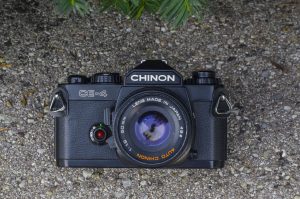
Part of the challenge and thrill of using old cameras is stepping back into the shoes of the people who originally purchased them. The more interesting a camera is, the more effort I have to put into the shots. The Chinon CE-4 comes from an era when most of the technical hurdles were worked out. I never found a sense of awe or a thrill when using it.
Hopefully this doesn’t come off as elitist as the Chinon CE-4 is a fine camera, its just kind of boring. It’s vanilla. The shooting experience was boring as well, and as a result, so were my images.
Simply, the Chinon CE-4 was a fine camera. It represented a pretty good value for photographers upon it’s release, and I am sure many people who bought them were happy with their purchase and chronicled many family events satisfactorily. I guess what I’m saying is that the time for the Chinon CE-4 has passed. As a collector and someone who enjoys shooting old cameras, I found nothing interesting about this model. Whether intentionally or not, the lackluster shooting experience transferred to my images, and well, they just aren’t that inspired…just like the camera.
So do I hate the Chinon CE-4? Should you add one to your collection? I guess my answer depends on what you’re looking for. If you need a simple, and adequate 35mm SLR that uses K-mount lenses, then yeah sure, this is a decent camera. It’s just that there are better options out there. Strangely, I would predict my verdict is the same reason that Chinon isn’t around anymore, and Pentax is.
My Final WordHow these ratings work |
The Chinon CE-4 is a well built and capable 35mm SLR camera made in the early 1980s. It offered features like aperture priority auto exposure, a vertically traveling metal blade shutter with fast 1/125 flash sync speed, and a bright and useful viewfinder which were consistent with mid-level cameras of it’s era. This camera accomplished everything it set out to do and provided a good value for it’s owners, especially when compared to more expensive models available by Nikon, Minolta, and Canon. The catch is, there are other models like the Chinon CE-4 that do all the same things, use the same lenses, and were sold for the same at the same, or even a lower price point making the decision to buy this model questionable. Today, this camera represents a good look at the type of camera many families took photos with in the early 80s. It doesn’t do any one thing particularly well or bad, and is a fine pickup for any collector looking for a bargain. As long as you don’t expect to be wowed by any amazing or innovative feature, you the CE-4 is a very solid middle of the road camera. | ||||||
| Images | Handling | Features | Viewfinder | Feel & Beauty | History | Age | |
| 2 | 1 | 1 | 1 | 1 | 0 | 0% | |
| Bonus | none | ||||||
| Final Score | 6.0 | ||||||
Additional Resources
http://camera-wiki.org/wiki/Chinon_CE-4
https://simonhawketts.com/2015/06/24/chinon-ce-4-35mm-slr-camera/

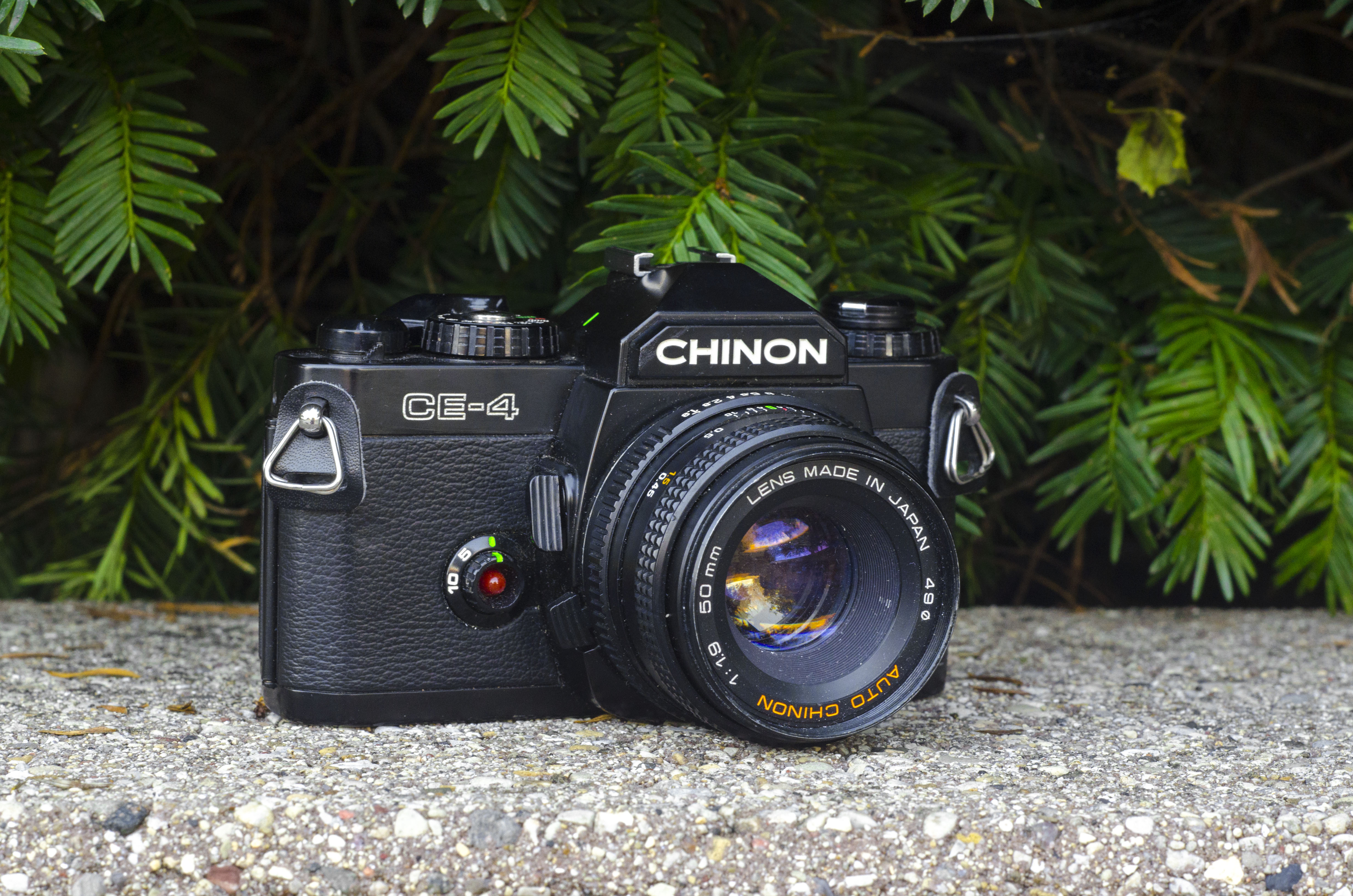
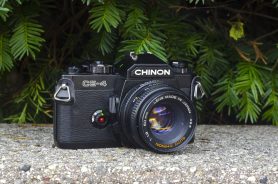
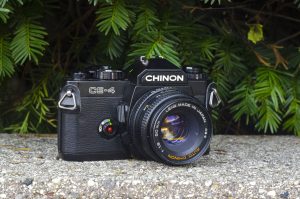








Good observation about the lack of excitement in a camera having the tendency to result in photos you are not excited about. It is an interesting side effect that cameras we find a joy to use tend to push us the most to create images that excite us as well.
However, in our “kid in a candy store” world of film cameras, where a once expensive model like this can be found for a dime a dozen, it’s not entirely possible to get into the shoes of the person who had saved their paychecks to be able to afford a camera like this that they’d seek to hang on to for many years to come.
I think these are good images from a solid and all too often overlooked camera. Regrettably, a model like this might all too often be bypassed as a $10 purchase by someone who readily plunks down $50 for something like a Pentax K-1000, but given that the limited film demand tends to cluster in a handful of models, a solid but unremarked example like this gets cast aside!
Final note: I love the research you put in to all of your articles, but can’t help but see the irony in how you can ferret out details on camera makers of 1930’s Japan, but details of the 1970’s makers and lines tend to be very scarce. I’ve encountered some of this very same bit of enigmatic luck!
The CE4s was my first ever SLR back in the mid 70’s and gave me years of faithful service,I bought it over the ME Super because of the more traditional layout and it’s larger size suited me better. I always thought the 50mm f1.7 and 135 f2.8 were good lenses and I use them now via adapters on my Micro 4/3rds bodies
Good Read.Showing both cameras side by side would gave some better impression about sizes or weight for the collector in me. Also a good contender to these both is the Cosina T9
Great review of the Chinon/Pentax competitors. I worked for Dixons in the UK during this period. Whilst the Chinon was a good camera, customers were under the impression that Chinon was a ‘Dixons own brand’ and to be avoided and tended to go for more mainstream brands. Shame really as they have stood the test time.
I also wonder if at least a certain percentage of would be customers were turned off by the name sounding sorta like “China” and not realizing they were a quality Japanese camera company.
To be honest, I think the chinon CE4 is today one of the best value 35mm cameras you can buy. I purchased one from Ebay recently for the princely sum of £11:45. For this, I received the camera complete with 50mm 1.7 multi coated lens, wide strap, case, & motorwind all in excellent condition and perfect working order. The passed sticker on the back says 07 this indicates the camera dates from July 1980.The only thing I needed to do was replace the seals and it’s almost as good as th day it left the factory. When you compare it with cameras like the pentax ME super, which is also an excellent camera, or the canon AE1, or the minolta X300, Olympus OM10, etc all of which command a considerably higher price, I cant think of a better value semi automatic camera. For the price of decent pub lunch, I can thoroughly recommend it.
GREAT Post! I LOVED using this camera – have had it since 1982 when I received it, along with the power winder, zoom, and some other accessories as a high school graduation present from my parents who purchased it second-hand. I’ve taken it to Italy, France, Israel, Mexico, Caribbean, and everywhere local in the past – heavy to carry but worth it. At the Vatican, where flash photography was not allowed, it took some photos that exceeded the quality of those in the tourism books for purchase. Unfortunately, with film photography not so much a thing of today and as my cell phone seems to be more than adequate and easier to use (all about convenience…), it has resided in it’s camera bag awaiting a decision from me for about 15 years. (Unfortunately, I haven’t been to Italy, France, or Israel in 15 plus years…I think I see a connection…)
Just a little nitpick: Zeiss did indeed release some of their primes with a K mount bayonet. They’re pretty scarce, though, and horribly expensive on the used market.
https://www.zeiss.com/consumer-products/int/photography/content/camera-mounts.html
Otherwise, good article about a predictably boring camera. The fact that the Japanese just had to make all of their damned SLRs look almost the same between the ‘70s and ‘80s is a shame, really.
I was that user in 1980 deciding between the CE4 and ME Super and I plumped for the Chinon a decision I never regretted,It served me well for a few years and when I got back into film it was one of the first cameras I went for,The lenses are excellent and it still works perfectly
Aha — I should have known that Mike would have the answer! Been collecting too many vintage film cameras and I have quite a collection now — with a batch of Chinon 35mm SLRs. But I could not find documentation as to why there were different “series” — CM, CE, CG — what did the different letter signify. Well, know I can see that “E” meant electronic shutter and “M” meant mechanical. Not sure how “G” fits in there though! For the most part they hold up pretty well. I have a few with flaky internal electrical connections for the meter, but the shutters still work. And I discovered with the Chinons a fix for a common problem with electronic-shutter cameras. I have ended up with many (different manufacturers) where the shutter won’t fire, even with new batteries. Often the mirror is stuck in the up position. I have found that for most if I set the self-timer and run it, then it seems the only way to properly trigger and “unstick” the shutter release function. After that the shutter seems to work fine. Anyway — thanks again Mike! And if you know what the “G” in the Chinon CG-series cameras stands for — let me know!
Dana, that’s a good question. I’ve never come across a CG camera, but looking up the CG-5, it came later than both the CE and CM and features the Pentax K-bayonet mount and had an electronic focal plane shutter. I think it also supported one auxiliary auto focus lens too. Maybe the “G” meant “Generation” like as it a next Generation camera. Just a wild guess though!
Hee hee — and it gets more fun! Will be bidding on a Chinon CS-4. According to the camera-wiki list of Chinon SLRs (it is quite a list!) — Chinon had an early model named CS (got one) — and CS stood for Chinon Screw (mount). And the only other CS model is CS-4 (which, according the manual on the Butkus website, is M42 screw mount). But what happened to CS-1 through CS-3? 🙂 I’m going to have a wall full of Chinon SLRs when I am done! So far I find that most of them work — and with PK/M42 lenses to choose from, as long as the camera body exposes the film correctly, what’s to lose? Thanks Mike!
My second 35mm camera, (the first been a Zenith B) was a Chinon CE4 bought from Dixons who were the UK seller of the cameras. Bought it the day before we went to America. Took some great photos over the years with it. Also had a Chinon super 8mm cine camera.
If I read your article correctly, you found the Chinon CE4 ‘boring’ and as a result of this,the photographs you took are also boring. I find this rather silly. When I go and make images the last thing on my mind is how interesting or entertaining the tools of my trade are. Perhaps if you concentrated on the images you were making instead of the camera you would have been more satisfied. The CE4 is more than adequate and has shown generally to offer better reliability than many more favoured/well known models. Reliability is not the strong suit of the Pentax ME Super or any Pentax electronic body.
I definitely hear what you’re saying, but perhaps a little more context is in order. I am not a photographer, I am a guy who likes shooting old cameras. I have shot well over 400 different models over the past few years, and part of the reason I write these reviews, is to give instant feedback on a model that I, or perhaps finding my reviews online, have never shot before. I completely agree the Chinon CE4 is a fantastic camera that has proven itself throughout history to be “more than adequate”.
What my point was trying to convey though, is that some cameras are more interesting than others. I have found that many times before and after shooting the Chinon is that cameras that offer a pleasant or otherwise interesting shooting experience, can translate that into images that are more interesting. More specifically, if I have fun shooting a camera, I am more likely to have more fun making images. A great camera can inspire great images. I’ve seen it many times, that I get better images from cameras I like better. Cameras that are otherwise indistinguishable from many other similar models, often end up shooting images that are indistinguishable than others.
Of course that with practice and repetition, you can get great images from anything. A pinhole camera can shoot an award winning picture, but if it’s a chore to make those photos, you’re less likely to get them.
I find it interesting you think you aren’t a Photographer, when clearly you are but your reasons for being one are not the same as some Photographers who don’t care what gear they use as it’s about the end result, my first attempt at Live Music Photography was with a Chinon CE-4, stuffed it down my pants to sneak it into the venue, the pics were terrible of course but it insprired me to later on have a career taking Live Music Pics at the biggest Festivals in the UK.
If you believe that using ‘boring’ Cameras make you take boring pics then you need to focus more on the pics and not the gear, some of my best ever pics, personal and professional, were on ‘boring’ cameras because after all, ALL any camera does, if it’s £5 or £5k, is 3 things to get the picture, and any picture is only made up of 3 things, the rest is up to the user. (A lot of people mistakenly think good or ‘best’ pictures are about focus and quality and that couldn’t be further from the reality of Photography) Nice article BTW.
Great article. Good option for a beginner’s camera with a low price and ability to accept more lenses.
Good review
Thanks!
I just bought a CE-4 to accompany my Contax RTS II. (Both get to use the same M42 lenses).
The CE-4 isn’t ‘boring’ in the slightest. It’s a handsome and compact camera with a big VF – as big as the Pro level VF in the Contax albeit ever so slightly darker – but brighter than that in a Contax 139q. The camera is smaller than the RTS II and is lighter (it’s as well built as an Olympus OM2 but not
Many cameras can match the RTS II) so easy to carry with just a wrist strap.
The shutter sound on it is fantastic – lovely sound and the delicate tactile ratcheting sound of the film advance lever is a pleasure to use – unlike the characterless sounds of the RTS II’s shutter and film advance. In looks it’s more handsome than any Canon Minolta or Nikon SLR and I prefer the look to that of an Olympus OM. The Contax RTS II is probably the most handsome SLR ever made but that’s a different story.